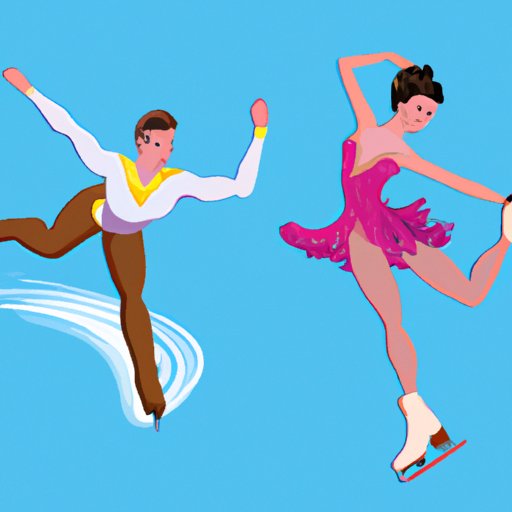Introduction
Figure skating and ice dancing are two popular sports that involve skaters performing on an ice rink. While these two activities have similarities, there are also many differences between them. To better understand the distinctions between figure skating and ice dancing, it is important to explore their definitions, technical elements, creative differences, scoring systems, music, costumes, and movement.

Definition of Figure Skating and Ice Dancing
Figure skating is a sport that involves athletes performing jumps, spins, and other complex moves on the ice. It is typically performed to music and is judged according to its technical difficulty, artistic impression, and execution. Ice dancing is similar to figure skating but with different rules. In ice dancing, couples move together in intricate patterns to music and are judged on their skating skills, artistry, and interpretation of the music.

Overview of the Differences between Figure Skating and Ice Dancing
The main difference between figure skating and ice dancing is the type of movements required. Figure skating requires more athletic and powerful jumps, spins, and other technical elements, while ice dancing focuses on intricate footwork and close partnering. Additionally, figure skating has a much larger variety of jumps and spins than ice dancing. Finally, figure skating is usually performed solo or in pairs, while ice dancing is always performed by a couple.
Comparing the Technical Elements of Figure Skating and Ice Dancing
In order to compare the technical elements of figure skating and ice dancing, it is important to look at what is considered a technical element for each sport. Figure skating includes jumps, spins, and footwork as technical elements. Jumps are aerial maneuvers in which skaters take off from the ice and land on one foot. Spins involve skaters rotating on one spot on the ice, and footwork includes intricate steps and turns. In ice dancing, the technical elements include pattern dances, twizzles, lifts, throws, and spin sequences. Pattern dances are specific patterns that must be repeated multiple times on the ice. Twizzles are rotational movements of one or both skaters in unison. Lifts involve one skater lifting the other in the air. Throws, like lifts, involve one skater throwing the other into the air. Spin sequences involve both skaters spinning around each other in a circle.
Exploring the Creative Differences between Figure Skating and Ice Dancing
Choreography plays a large role in both figure skating and ice dancing, however, the way it is used differs greatly between the two sports. In figure skating, choreography is used to create a program that showcases the skater’s athleticism and artistry. This can include a wide range of elements such as jumps, spins, and footwork. In ice dancing, choreography is used to create intricate patterns and movements that showcase the couple’s ability to skate together. This includes elements such as pattern dances, twizzles, lifts, throws, and spin sequences.

Investigating the Scoring Systems for Figure Skating and Ice Dancing
Another key difference between figure skating and ice dancing is the scoring system. In figure skating, a panel of judges evaluates each skater’s performance using a points system. This system assigns a numerical score based on the skater’s technical difficulty, artistic impression, and execution. The highest possible score is 6.0, and the lowest is 0.0. In ice dancing, the judging system is slightly different. A panel of judges evaluates the couple’s performance based on their skating skills, artistry, and interpretation of the music. Judges assign a base value to each element of the performance, and then add or subtract points depending on how well the couple performs. The highest possible score is 10.0, and the lowest is 0.0.
Examining the Music, Costumes, and Movement in Figure Skating and Ice Dancing
Music is another area where figure skating and ice dancing differ. In figure skating, the skater chooses their own music, which can range from classical to pop. In ice dancing, the couple must choose music that fits into a specific category, such as waltz or tango. The costumes worn in each sport also vary. Figure skating costumes are often bright and flashy, while ice dancing costumes are usually elegant and understated. Finally, the movement in each sport is different. In figure skating, the skater must move in a powerful, athletic manner. In ice dancing, the couple must move together in a graceful and synchronized way.
Evaluating the Popularity of Figure Skating and Ice Dancing
Figure skating is one of the most popular winter sports, with millions of fans around the world. Ice dancing is not as popular as figure skating, but it still has a dedicated following. Both sports draw large audiences when they are broadcast on television, and they attract top-level athletes who strive to become world champions.
Conclusion
Figure skating and ice dancing are two sports that involve skaters performing on the ice. While they share some similarities, there are also many differences between them. These include their technical elements, creative differences, scoring systems, music, costumes, and movement. Additionally, figure skating is much more popular than ice dancing. Understanding the distinctions between figure skating and ice dancing can help people appreciate the beauty and complexity of both sports.
(Note: Is this article not meeting your expectations? Do you have knowledge or insights to share? Unlock new opportunities and expand your reach by joining our authors team. Click Registration to join us and share your expertise with our readers.)
